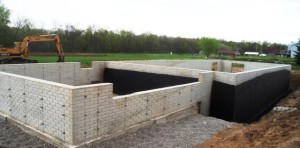Poured basement insulation is rather challenging in cold climates. Insulating basement walls in cold climates is a great way to keep your home warmer and drier. However, special care should be used when insulating concrete basement walls. Below grade concrete foundation walls are very col and damp. If you were to insulate the walls with regular fiberglass batt insulation it is very likely that a mold problem would develop.
There are two critical factors in determining how much heat you’ll keep in your home to achieve an excellent poured basement insulation. The first is the difference in temperature between the inside and the outside of the building. As you’d expect, the greater the difference the greater the heat loss. The second factor is the degree of heat retention in your walls, floors and ceilings. To keep things relatively simple, we will focus on heat retention in the walls.
Poured Basement Insulation: Difference in Temperature
Imagine a 20′ x 30′ x 8′ high basement with 8″ [20cm] thick concrete walls and 2′ exposed (above grade). If the temperature inside is 70°F and the temperature outside is 20°F , the heat loss through just the 2′ exposed portion of the wall is 15,625 BTUs per hour (370,000 BTUs per day). Let’s further imagine that the house is located in a cold winter climate where frost extends 2′ below grade. This means that the 2′ above grade and the 2′ in the frost zone will all essentially be exposed to the
The entire area above the frost line is subject to huge heat losses. Below the frost line, heat loss is significant but not as extreme. 2′ Above Grade 2′ Above Frost Line, Below Grade 4′ Below Frost LineKevin Spaulding Page 2 Miles Supply, Barre, VT 20°F outdoor temperature. The 4′ [1.2m] that is below the frost line will be exposed to a relatively balmy ground temperature of 50°F. With the upper 4′ [1.2m] of the basement wall exposed to 20°F and the bottom 4′ exposed to 50° F, the total heat loss through the cement walls would be 43,750 BTUs per hour (1,050,000 BTUs per day!). This equates to over four cords of oak or sugar maple firewood (at 20% moisture content) to warm only the basement over three winter months.
Poured Basement Insulation: Heat Retention inside the House
The R-Value of a material is a measure of its thermal resistance. The higher the number, the greater the resistance and the better the insulating value. There are a number of materials used in home construction that have very low R-Values.
R-Values are cumulative. For example, if you were to insulate a wall with R-11 fiberglass batt and sheath it with ½” [1.3cm] sheets of Thermax™ and ½” [1.3cm] sheetrock, the total R-Value would be 14.75. The minimum insulation (R-Value) recommended by the Department of Energy for horizontal below grade surfaces in cold climates is R-10 to R-15.
If you are building your house, you have the advantage of being able to insulate properly right from the start. There are many excellent methods for creating a well insulated basement.
In case you still have question about the type of modular home foundations, you may contact Legendary Homes Inc in Jackson, Michigan. A representative will be happy to assist you. Meanwhile you can check our modular home price sheets by signing up to our blog.
Topic: Poured Basement Insulation
The Value of Poured Basement Insulation in Adrian, Michigan

No comments:
Post a Comment